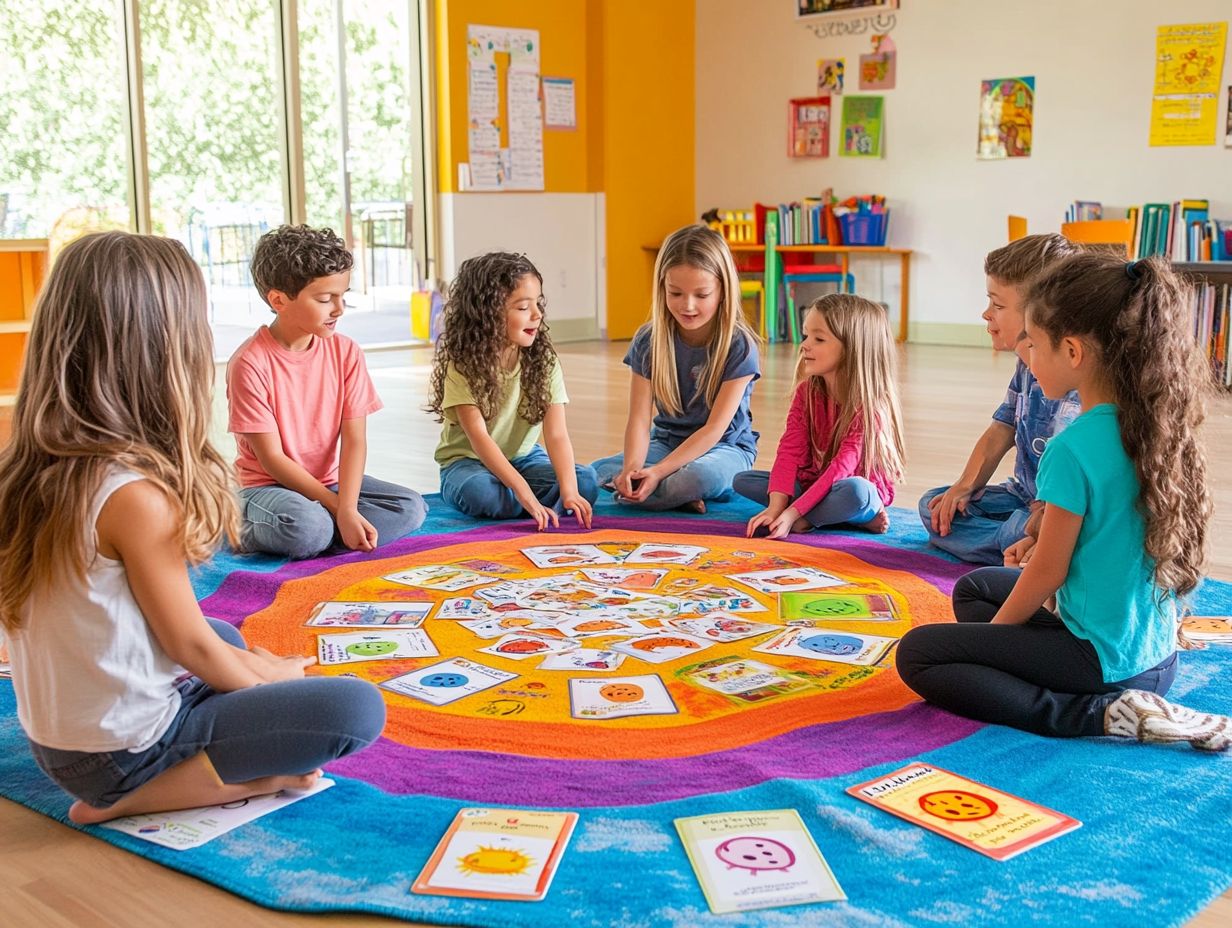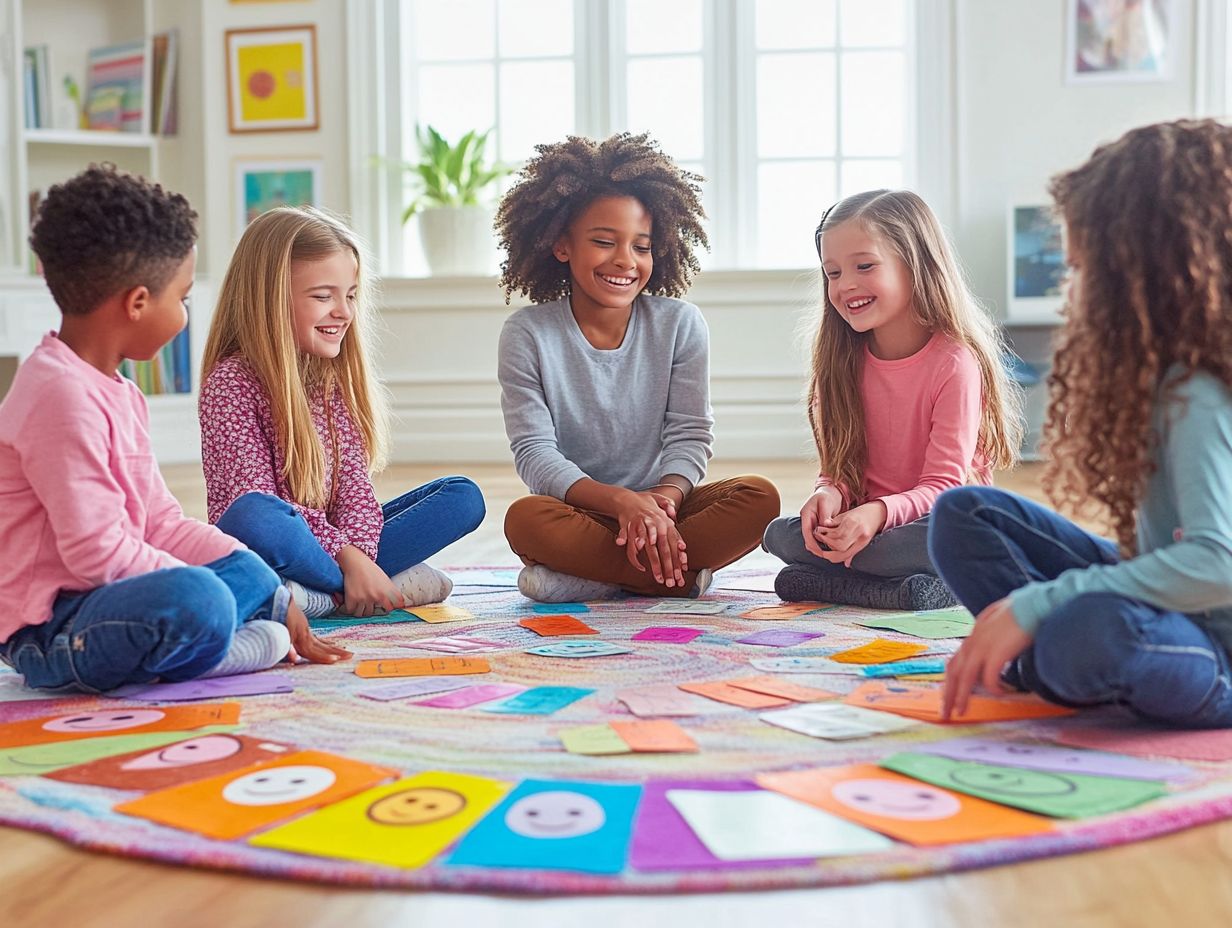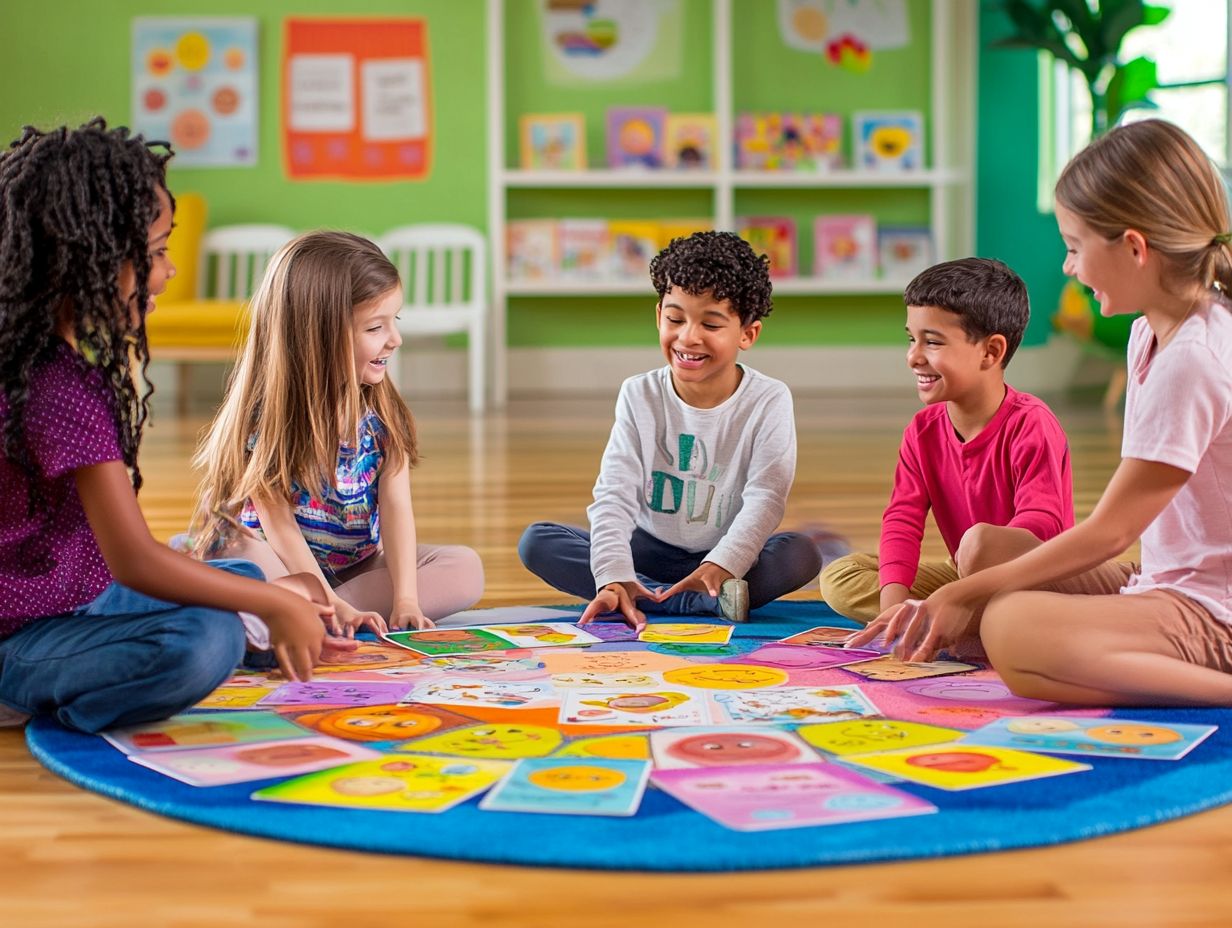How to Teach Kids Emotional Regulation
Emotional regulation is an essential skill that empowers children to navigate their feelings and emotional reactions in a healthy manner. As they encounter various emotional challenges, learning to manage their emotions becomes crucial for their overall emotional development.
This discussion will underscore the importance of teaching emotional regulation, delve into the potential repercussions of inadequate emotional management, and present practical parenting strategies and techniques for teachers to help children master this vital skill.
By incorporating engaging activities and mindfulness techniques, you can cultivate emotional resilience and enhance the emotional well-being of your child.
Contents
Key Takeaways:

- Teaching kids emotional regulation is crucial for their emotional well-being and success in life.
- Poor emotional regulation in children can lead to difficulties managing emotions, impulsive behavior, and social problems, particularly during key developmental stages.
- Parents and teachers can support emotional regulation by modeling healthy habits, teaching coping strategies, and providing a safe and supportive family environment.
What is Emotional Regulation?
Emotional regulation is your capacity to understand and manage your emotions effectively, a skill that is crucial for children as they move through various developmental stages. It involves recognizing both primary emotions and secondary emotions and learning how to respond appropriately to emotional triggers, which are situations that cause strong feelings. This process fosters emotional intelligence and awareness in kids.
By teaching emotional regulation, you empower children to develop self-soothing behaviors, enhance their emotional expressions, and improve their coping skills. Ultimately, this equips them with the essential tools to manage their emotions in a healthy and constructive way.
Why is it Important to Teach Kids Emotional Regulation?
Teaching your kids about emotional regulation is essential for their overall well-being and development. It equips them with the skills they need to understand their emotions and respond effectively to emotional challenges.
This foundational skill fosters emotional intelligence, allowing children to navigate their social environments, build stronger relationships, and cope with a spectrum of feelings be it anger, fear, sadness, or joy.
As your children learn to manage their emotions, you ll likely notice an enhancement in their social skills. This paves the way for healthier interactions with both peers and adults. Emotional resilience becomes another significant advantage, enabling them to bounce back from setbacks and face challenges with a renewed, positive outlook.
You play a crucial role in this journey. By modeling emotional regulation techniques such as practicing mindfulness and engaging in open discussions about feelings you set a powerful example.
Creating a supportive family environment that encourages emotional expression reinforces these skills, providing your children with a safe space to explore their emotions and develop a robust emotional toolkit for the future.
What Are the Effects of Poor Emotional Regulation in Children?
When children struggle with poor emotional regulation, the repercussions can be significant. You may notice emotional dysregulation, challenges in managing their feelings, and impulsive behaviors surfacing. Emotional invalidation from peers or adults can further exacerbate these issues.
If a child finds it difficult to recognize and navigate their emotional landscape, they might display disruptive behaviors or intense emotional reactions that can influence their relationships and overall well-being. This struggle can have lasting effects on their social and emotional development, making it crucial to address these issues early on.
1. Difficulty Managing Emotions
When children struggle to manage their emotions, they often find it difficult to cope with emotional triggers. This can lead to inappropriate responses or outbursts, significantly impacting their ability to build healthy relationships and navigate social situations. They may lack the skills to calm themselves down or use effective strategies when faced with emotional challenges.
Consider a child who feels overwhelmed during significant transitions, like moving to a new school or dealing with parental separation. These situations can evoke feelings of anxiety and sadness. Without adequate emotional regulation strategies, their reactions may manifest as anger or withdrawal.
Teaching kids these skills is crucial! You can help them learn effective coping methods, such as deep breathing, mindfulness, or engaging in creative activities. For more strategies on how to help kids manage emotions mindfully, fostering these self-soothing techniques empowers children to recognize their triggers and respond to challenging emotions in a healthy manner.
2. Impulsive Behavior

Impulsive behavior in children often arises from emotional dysregulation. They act on their immediate feelings without considering the consequences, which can manifest in various ways, such as aggressive outbursts or hasty decision-making. This can profoundly affect their interactions with peers and adults.
Imagine a child abruptly shouting out answers in class without raising their hand or reacting in anger when things don’t go their way. These actions typically stem from underlying emotions like frustration, anxiety, or sadness that the child struggles to manage.
To support children facing these challenges, caregivers and educators can implement behavior management techniques. Establishing clear expectations and using positive reinforcement can be incredibly beneficial. Teaching coping strategies, like deep breathing or counting to ten before reacting, can also help.
By addressing both the impulsive behaviors and the emotional roots behind them, you create a supportive environment that encourages positive social interactions.
3. Social and Relationship Problems
Social and relationship problems often stem from a lack of emotional intelligence and emotional awareness in children. This can significantly hinder their ability to empathize and communicate effectively with others. As a result, they may find it challenging to establish healthy friendships, leading to feelings of isolation and heightened emotional distress.
This struggle to recognize and manage their own emotions can lead to various social challenges, including bullying, difficulty resolving conflicts, or misreading social cues. For instance, a child who struggles to understand their feelings might react with aggression when faced with rejection, inadvertently pushing peers away.
To address these challenges, fostering emotional support through role-playing activities can prove beneficial. These strategies enhance emotional regulation and promote essential interpersonal skills, empowering children to navigate social environments more effectively.
How to Teach Kids Emotional Regulation?
Teaching kids emotional regulation requires a comprehensive approach that enhances their emotional intelligence. This involves effective communication strategies, modeling emotional awareness, and offering consistent support. Incorporating age-appropriate materials and activities can also be extremely beneficial.
By doing this, you empower children to learn how to manage their emotions and develop strategies that will serve them well in various situations, including challenging ones. Don’t wait start teaching these skills today!
Start implementing these strategies today to empower your child!
1. Model Healthy Emotional Regulation
Modeling healthy emotional regulation is one of the most powerful ways for you to teach children how to manage their own emotions. They learn by observing your behaviors and reactions. By demonstrating emotional awareness and self-regulation skills in your daily life, you provide them with a vital framework for understanding and expressing their emotions appropriately.
When you remain composed during stressful situations like navigating traffic or dealing with household mishaps you impart invaluable lessons on how to handle frustrations without resorting to outbursts. Taking a moment to breathe deeply or express feelings of frustration calmly helps children grasp the significance of emotional awareness. By openly discussing your feelings and acknowledging moments of anger or disappointment, you create a safe environment where kids can learn to articulate their own emotions and practice emotional coping techniques.
Encouraging reflection on feelings instead of suppression not only enhances their emotional intelligence but also strengthens family bonds through open communication.
2. Help Children Identify and Label Their Emotions
Helping children identify and label their emotions is a crucial step in fostering emotional regulation. By nurturing emotional awareness, you enhance their ability to articulate their feelings effectively. Teaching kids to recognize both primary emotions and secondary emotions allows them to navigate their emotional landscape with greater ease.
Using techniques like emotion charts can be particularly beneficial in emotional learning. These charts visually represent various feelings, enabling children to connect words to their experiences in a meaningful way. Storytelling also serves as a powerful tool; relatable characters allow kids to witness emotional scenarios that reflect their own situations, creating a sense of connection and understanding.
Validating their emotional expressions is essential, as it reassures children that their feelings are legitimate and worthy of conversation. Encouraging them to share their emotions perhaps through age-appropriate prompts or engaging discussions opens the door for deeper exploration of their feelings. This reinforces their emotional vocabulary and cultivates a supportive environment that champions emotional expression.
3. Teach Coping Skills

Teaching children effective coping strategies is crucial for their emotional well-being and growth! By introducing self-soothing behaviors and calming techniques, they learn to manage emotions constructively, fostering resilience and emotional intelligence.
These strategies can include deep breathing exercises, where they take slow, deep breaths to calm their minds, or visualization techniques that involve imagining a peaceful place to escape overwhelming emotions. For instance, during challenging situations like taking a test or navigating a tough peer interaction, practicing these methods helps them feel more grounded and composed.
Engaging in physical activities such as running or dancing also channels excess energy and alleviates stress, aiding in emotional management. It s crucial for children to practice these techniques regularly; consistency will reinforce their effectiveness and empower them to handle emotional challenges more effectively over time.
4. Encourage Open Communication
Encouraging open communication within your family creates a supportive environment that nurtures emotional development and growth. When your children feel safe expressing their emotions without the fear of being emotionally invalidated, they are far more likely to cultivate healthy emotional expressions and coping skills.
A nurturing atmosphere helps your children articulate their feelings and equips them with self-regulation skills. You can promote this open dialogue by actively listening, validating their emotions, and responding with empathy and emotional feedback.
Try exciting strategies, such as setting aside dedicated time for conversations, using storytelling to prompt discussions about feelings, and modeling emotional expression. These create valuable opportunities for your children to communicate openly. Regular family meetings where everyone shares their thoughts and feelings can further enhance this practice.
The emotional support you provide as a family member plays a transformative role. It empowers your children to navigate their feelings effectively and build resilience when faced with challenges.
Activities for Kids to Practice Emotional Regulation
Engaging children in activities specifically designed for practicing emotional regulation can profoundly enhance their ability to manage emotions and cope with emotional challenges.
These activities often integrate mindfulness techniques and creative outlets. They not only promote emotional expression but also equip children with essential skills for navigating their feelings in a healthy manner.
1. Mindful Breathing Exercises for Emotional Regulation
Mindful breathing exercises serve as simple yet effective tools for helping children understand their feelings and practice calming techniques in times of distress. By directing their focus to their breath, they can learn to center themselves, fostering emotional regulation and alleviating feelings of anxiety or anger.
These exercises are easily accessible and can fit seamlessly into daily routines, making them invaluable for emotional development. To get started, find a quiet space where they can sit comfortably, whether on the floor or in a chair. Encourage them to close their eyes and take a deep breath in through their nose, counting to four, then exhaling slowly through their mouth for a count of six.
Repeat this process several times, guiding them to feel the rise and fall of their chest. This nurtures a calming connection to their body. Consistent practice enhances relaxation during challenging moments and equips them with essential coping mechanisms that stabilize their emotions over time.
2. Role-playing Situational Emotions
Role-playing scenarios provide an interactive way to explore emotional expression and practice behavior management in various social situations. Through guided role-playing, you can rehearse responses to emotional challenges, enhancing problem-solving skills and emotional regulation.
These exercises can take many forms, from simple improvisational games to structured situations, such as dealing with a bully, resolving a conflict with a friend, or expressing feelings in challenging scenarios like losing a game. By immersing yourself in these experiences, you bolster your emotional intelligence and develop resilience in the face of real-life challenges.
For instance, participating in a group activity where you act out different roles in a family setting helps kids understand diverse perspectives, leading to greater empathy and improved communication skills. Ultimately, role-playing serves as a powerful tool, equipping you with the emotional skills necessary to navigate evolving social landscapes.
3. Creating a Feelings Chart

Creating a feelings chart can be both enjoyable and enlightening. It serves as an effective tool for helping children identify and articulate their emotions, thereby enhancing their emotional awareness.
By visually representing various feelings, children can learn to express their emotions with greater clarity and recognize their emotional states, including primary emotions and secondary emotions, more easily.
To craft an engaging feelings chart, start by brainstorming a list of emotions, such as happiness, sadness, anger, and excitement. Each emotion can be paired with expressive visuals think emojis or drawings that provide a clearer understanding for the child.
Adding labels for each feeling, along with relatable scenarios, can help them connect more personally with these emotions.
By consistently referring to this chart, children can reinforce their ability to identify and express their emotions. This ultimately fosters their emotional intelligence.
Regular discussions about how they feel in different situations will empower them to articulate their emotions confidently, making it much easier for them to navigate their feelings in daily life.
4. Using Art to Express Emotional Dysregulation
Art is an amazing way for children to express themselves and explore their feelings! Using art as a means of expression serves as a powerful outlet for children to convey their emotions, significantly enhancing their emotional development and self-soothing abilities.
Engaging in creative activities such as drawing, painting, or crafting allows kids to explore and articulate their feelings in a safe and constructive environment.
Incorporating these artistic endeavors into daily routines encourages regular emotional expression. Simple practices like doodling during quiet moments or collaborating on projects with caregivers can enrich this routine.
The therapeutic benefits of such artistic forms are truly remarkable. They not only aid in emotional regulation but also help develop resilience and self-awareness.
By seamlessly integrating artistic expression into everyday life, children can develop healthier mechanisms for processing their emotions and communicating their inner experiences.
This ultimately leads to a deeper emotional understanding.
How Can Parents and Teachers Support Emotional Regulation in Children?
Parents and teachers hold a crucial position in fostering emotional regulation in children. They can utilize effective parenting strategies and communication techniques to cultivate a nurturing atmosphere.
By offering consistent emotional support and ensuring a safe family environment, they can empower children to develop vital self-regulation skills. This enables them to navigate their feelings with greater ease and confidence.
1. Create a Safe and Supportive Environment
Creating a safe and supportive environment is essential for helping children feel secure in expressing their emotions. When they sense emotional safety within their family or classroom, they are much more likely to engage in open communication and seek out emotional support during tough times.
This solid foundation fosters emotional validation, allowing children to gain recognition for their feelings. It gives them the power to understand and articulate their emotions with greater clarity.
The presence of positive reinforcement encourages kids to display desirable behaviors, reinforcing their sense of worth and belonging.
By prioritizing emotional safety, you can significantly enhance behavior management techniques, leading to improved self-regulation.
When children are met with understanding and compassion, they develop healthier coping strategies. This ultimately creates a more harmonious atmosphere that fosters learning and growth.
Start incorporating these strategies today to empower your child on their emotional journey!
2. Provide Consistent and Clear Boundaries
Providing consistent and clear boundaries is essential for guiding children toward healthy emotional regulation, as it helps them understand expectations and the consequences of their emotional reactions. When children feel secure within established limits, they become better equipped to manage their emotions and navigate social situations effectively.
This stability also fosters resilience and gives them the power to express themselves appropriately, promoting stronger relationships with others. It’s important to recognize that consistency in maintaining these boundaries plays a crucial role in behavior management. When you provide emotional guidance and support, you reinforce the significance of these limits, enabling children to learn from their experiences.
By reinforcing positive behaviors and gently correcting negative ones within a structured environment, children build trust in your intentions and develop a sense of autonomy. Therefore, a balanced approach that integrates emotional support with clear boundaries nurtures their emotional intelligence and lays the groundwork for responsible decision-making as they grow.
3. Seek Professional Help if Needed
When children exhibit persistent emotional challenges that impede their emotional development, it may be necessary for you to seek professional help to provide additional guidance. Mental health professionals can offer valuable insights and tailored strategies that cater to their individual needs, fostering healthier emotional regulation and effective coping mechanisms.
This journey often begins with recognizing signs such as anxiety, depression, or behavioral issues that may feel overwhelming to handle alone. Therapists or counselors trained in child psychology can create a safe space for children, nurturing their ability to express their feelings constructively.
By employing therapeutic techniques, these professionals help children develop essential skills like impulse control and self-awareness. These clinical interventions work in tandem with the support provided by you as a parent and by teachers, forming a comprehensive approach that enriches a child’s emotional toolkit for navigating life’s challenges.
Frequently Asked Questions
How can I teach my child emotional regulation?
- Model healthy emotional regulation yourself. Children learn by watching and imitating their parents, so make sure you are managing your own emotions in a healthy way.
- Teach your child to recognize and label their emotions. Use simple words like happy, sad, angry, or scared to help them identify their feelings.
- Validate your child’s emotions. Let them know that it’s okay to feel a certain way and that all emotions are valid.
- Practice deep breathing or other calming techniques with your child. This can help them learn to manage their emotions when they start to feel overwhelmed.
- Use books or role-playing to teach your child how to handle difficult emotions. This can help them understand that it’s normal to feel upset and that there are healthy ways to cope.
- Consistently reinforce and praise your child’s efforts to regulate their emotions. Positive reinforcement can go a long way in helping them develop this important skill.






